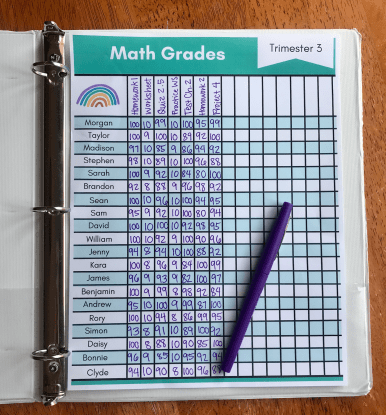My very first day of student teaching in the winter of 2020, my mentor teacher sat me down. She was ready to give me the lay of her 4th grade land, and I was eager to absorb all the wisdom she had to share. She was, after all, a teacher who held decades of experience and would be coaching me through the upcoming semester.
She pulled out a binder, slapped it on the table, and looked me in the eyes. “Rule number one,” she said, “Always keep a paper grade book.”
I nodded; this was some serious advice. She explained that in her 35 years of teaching she had seen it all: Internet failures the day of parent-teacher conferences, malfunctions in system passwords, and the instant loss of grade records.
She said the most reliable way to keep grade records is with pencil and paper.
How I Use It
Fast forward to four years later, where I have experienced firsthand the importance of the paper grade book.
Now, I’m not saying I sit down and calculate grade averages by hand. Instead, I’m talking about writing down students’ grades in my own binder to have a back up copy of their scores. I still enter these grades into my school’s online system, but this is my first step.
I have learned to love setting up a fresh grade book each trimester. I copy the names of students from my roster in alphabetical order, add a title describing the class, and am ready to go.
As I am grading assignments, I simply write in the grades as I go. Because I have recorded the information alphabetically, this makes transferring them online a breeze.
It also saves me time. I can record what I need while grading, then login to the online system later. I often do all of my transferring from paper to portal in a single planning period once a week.
Why It’s Helped
I can’t tell you the amount of times I think I am done adding grades online, only to go back and see a big mistake. For instance, the class average of a homework assignment is suddenly above 100%. What went wrong here? A typo on my part.
I can easily go back to the grade postings and see what happened. Luckily, I also have my paper grade book to reference and check my work. Typically, I have done something that stands out, like added an extra 0 to a grade, which changes a 90% to a 900%. Every once in a while, though, I make a mistake that is not as obvious. The paper grade book has saved me in these cases.
Another time, the words spoken by my mentor teacher echoed true. A student was moved from another class into mine, and her previous grades had disappeared online. The teacher she had before did not have a paper record of her grades. Thankfully, the office found a way to recover the grades, but it could have been a disaster.
How to Start
A new school year sounds like the perfect time to start this practice, but you can begin any time of year.
My first year teaching, I had a spiral grade book from a closet of random teacher supplies. It did the job, but it wasn’t really my style, and honestly, I felt that I wasted a lot of paper. It seemed to be designed for high school teachers with lots of different classes on their plates.
I designed my own grade book exactly how I like it. You can also check it out by clicking on the image below. I have included a rainbow of colors and templates for 20, 25, and 30 students in a class. This design is entirely editable, so you can also adjust it to fit your classroom needs.
The bright colors keep me organized, and I always include the subject area and trimester. This is helpful for the duration of an entire school year.
Let me know how it works for you in the comments below. I hope you enjoy, and please, use a paper grade book for peace of mind!





Comments